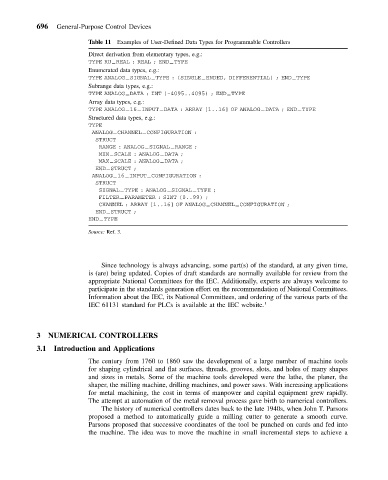Page 705 - Mechanical Engineers' Handbook (Volume 2)
P. 705
696 General-Purpose Control Devices
Table 11 Examples of User-Defined Data Types for Programmable Controllers
Direct derivation from elementary types, e.g.:
TYPE RU REAL : REAL ; END TYPE
Enumerated data types, e.g.:
TYPE ANALOG SIGNAL TYPE : (SINGLE ENDED, DIFFERENTIAL) ; END TYPE
Subrange data types, e.g.:
TYPE ANALOG DATA : INT (-4095..4095) ; END TYPE
Array data types, e.g.:
TYPE ANALOG 16 INPUT DATA : ARRAY [1..16] OF ANALOG DATA ; END TYPE
Structured data types, e.g.:
TYPE
ANALOG CHANNEL CONFIGURATION :
STRUCT
RANGE : ANALOG SIGNAL RANGE ;
MIN SCALE : ANALOG DATA ;
MAX SCALE : ANALOG DATA ;
END STRUCT ;
ANALOG 16 INPUT CONFIGURATION :
STRUCT
SIGNAL TYPE : ANALOG SIGNAL TYPE ;
FILTER PARAMETER : SINT (0..99) ;
CHANNEL : ARRAY [1..16] OF ANALOG CHANNEL CONFIGURATION ;
END STRUCT ;
END TYPE
Source: Ref. 3.
Since technology is always advancing, some part(s) of the standard, at any given time,
is (are) being updated. Copies of draft standards are normally available for review from the
appropriate National Committees for the IEC. Additionally, experts are always welcome to
participate in the standards generation effort on the recommendation of National Committees.
Information about the IEC, its National Committees, and ordering of the various parts of the
IEC 61131 standard for PLCs is available at the IEC website. 1
3 NUMERICAL CONTROLLERS
3.1 Introduction and Applications
The century from 1760 to 1860 saw the development of a large number of machine tools
for shaping cylindrical and flat surfaces, threads, grooves, slots, and holes of many shapes
and sizes in metals. Some of the machine tools developed were the lathe, the planer, the
shaper, the milling machine, drilling machines, and power saws. With increasing applications
for metal machining, the cost in terms of manpower and capital equipment grew rapidly.
The attempt at automation of the metal removal process gave birth to numerical controllers.
The history of numerical controllers dates back to the late 1940s, when John T. Parsons
proposed a method to automatically guide a milling cutter to generate a smooth curve.
Parsons proposed that successive coordinates of the tool be punched on cards and fed into
the machine. The idea was to move the machine in small incremental steps to achieve a

